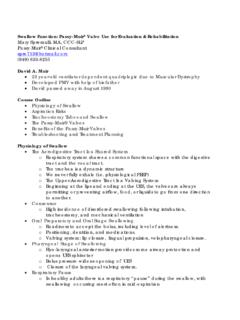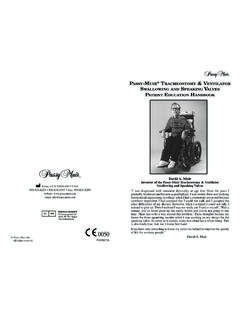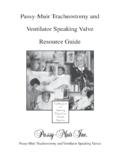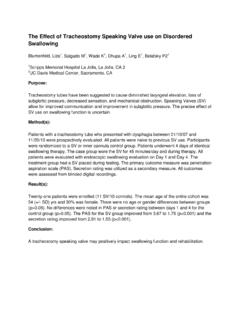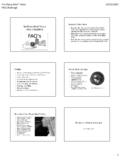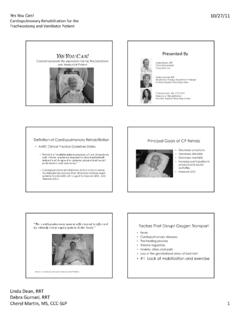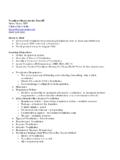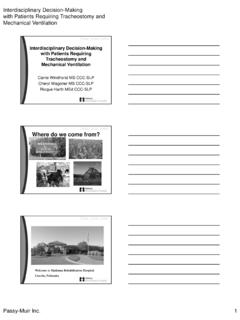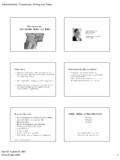Transcription of Ventilator Application of the Passy-Muir Valve
1 Ventilator Application of the Passy-Muir Valve Michael S. Harrell, , RRT Director of Clinical Education-Respiratory (949) 833-8255 David A. muir 23 year-old Ventilator dependent quadriplegic due to Muscular Dystrophy Developed PMV with help of his father David passed away in August 1990 Course Outline Benefits of the Biased Closed Position No Leak Design Passy-Muir Valve Assessment and Placement Ventilator Connections Cost Effectiveness of Passy-Muir Valve Use Case Studies Benefits Review of the Biased Closed Position No Leak Passy-Muir valves Physiologic Benefits of Passy-Muir Valve (Review)
2 O 100% airflow through upper airway on exhalation Clinical Benefits Review o Restores Voice/Communication o Improves Swallowing o Promotes Weaning and Decannulation o Improves Secretion Management o May Decrease Risk of Aspiration o Restores Physiologic PEEP o Improves Olfaction Passy-Muir Valve Assessment and Placement- Set Yourself and your Patient up for Success! Patient Selection o Awake, alert attempting to communicate o Medically Stable o Able to tolerate cuff deflation - Ventilation status - Aspiration status o Able to manage secretions o Tube must be small enough to allow air to pass o Patient must have a patent upper airway o Can be placed 48-72 hours post tracheotomy Ventilation Criteria Suggestions o Patient on <.
3 60 FiO2 o PEEP requirements of <10cm H2O o PIP less than 40cm H2O Placement Guidelines o Patient education o Peer education team approach! o Body position and posture semi-Fowler s o Position of head and neck o Achieve cuff deflation slowly! (Pulmonary Toilet) o 100% Cuff Deflation is Mandatory Tube Position is Important Assessment Criteria o Observe pre-cuff deflation PIP o Observe pre-cuff deflation exhaled Vt o Achieve cuff deflation slowly over 5 minutes o Look for 40 - 50% loss of exhaled Vt o Look for significant drop in PIP o A: WHAT DOES THIS TELL YOU?
4 Assessment Criteria o A: This assessment is telling you your patient can exhale around the properly sized tracheostomy tube, and the airway above the cuff is most likely patent. Assessment Criteria o 100% Cuff Deflation o Patient must be able to exhale past the tracheostomy tube and through upper airway o Assess air leak/decreased ventilation o Compensate with Ventilator changes Cuff Inflated-Closed Circuit Cuff Deflated-Open Circuit Passy-Muir Valve In-line Ventilator Adjustments Ventilator Assessment and Adjustments o PEEP On/Off o Volume compensation during cuff deflation - Increase Vt in small increments to achieve pre-cuff deflation pressures (PIP)
5 O Use low pressure alarm as disconnect/indirect low exhaled Vt alarm (set above 10cm H20) o Set high pressure limit appropriately (10 15cm H20 above the PIP) o Pressure versus flow trigger o Pressure Support - Use E-Sense, inspiratory cycle off, or set I-time to time limit PS breath o Pressure Control - Set I-Time o Consider NIPPV mode Review o Adjust PEEP o Slow cuff deflation o Monitor pressure/volume loss o Place Passy-Muir Valve o Compensate for volume/pressure loss o Time limit PS breaths o Set alarms appropriately Humidification o Use with heat/moisture exchanger (HME)
6 Is ineffective o Use with heated humidified system o Remove Passy-Muir Valve for medicated treatment Ventilator Connections Ventilator Connections Patient Assessment o Monitor Baseline Parameters - Saturation - Heart Rate - Respiratory Rate - Work of Breathing (WOB) Cost Effectiveness of Passy-Muir Valve Use Cost Savings Case Studies Case Study #1 Neuromuscular patient - Multiple Sclerosis (MS) 32 yr old MS patient on Servo i o Ventilator Settings: - SIMV/PS - RR 8 - Vt 600 cc (PIP 20 cm) - PEEP 5 cm - FiO2 .28 - PS 15 cm o #8 Shiley tracheostomy tube Step Through the Process o Educate patient and staff o Place warning labels o Check position of head and neck o Note PIP and exhaled Vt o Provide pulmonary toilet and oral care o S L O W cuff deflation o Re-assess airflow for Vt and PIP changes Cuff Deflation Assessment o Exhaled Vt is now 500cc (was 600) o PIP is now 17 cm (was 20 cm) o Patient has poor cough o Patient is not making any sounds o Q: Would you place a Passy-Muir Valve ?
7 A: No, Valve is not placed in-line o Q: Why not? o Q:What are your recommendations? A: Changed to #6 Shiley o Your new assessment now reveals - Exhaled Vt 200cc (was 600) - PIP is now 8 cm (was 20) - Patient is coughing - Patient is verbalizing o Q: Would you place a Passy-Muir Valve ? o A: Yes Troubleshooting o The patient seems to be able to produce speech on inspiration and expiration o There is continuous flow in the circuit o Q: What two things should you troubleshoot? o A: PEEP setting o A: Time limit PS - E-Sense - Expiratory Sensitivity - Expiratory % - Inspiratory cycle off (this option is on the Servo i) - Set an inspiratory time / time limit your PS breath o Consider NIV mode Case Study#2 Failure to wean (FTW) 65 yr old FTW on PB 840 o Ventilator Settings: - SIMV/PS - RR 6 - Vt 700cc (PIP 32cm H2O) - PEEP 5cm H2O - FiO2.
8 40 - PS 15cm H2O - Total RR is 30-32 o 8 Shiley XLT for 2 months Step Through the Process o Educate patient and staff o Place warning labels o Check position of head and neck o Note PIP and exhaled Vt o Provide pulmonary toilet and oral care o S L O W cuff deflation o Re-assess airflow for Vt and PIP changes Cuff Deflation Assessment o Exhaled Vt is now 250cc (was 700) o PIP is now 12 cm (was 32cm H2O) o Patient has strong cough o Patient is making good vocal sounds o Q: Would you place a Passy-Muir Valve ? o A: Yes, Passy-Muir Valve is now in-line Q: What problems would you expect with the PB 840?
9 O A: Unable to silence circuit disconnect alarm o PS breaths have extended o I-times Troubleshooting o Patient RR climbs to 38 BPM quickly o Q: What two things should you troubleshoot? o A: - Check trigger sensitivity - Consider increasing Vt to reach pre-cuff deflation PIP (this assures proper alveolar VE ) - Time limit PS breath Q: Why does NIV mode promote successful Passy-Muir Valve use? o A: - Disconnect sensitivity automatically shuts off - Volume alarms default to off - Practitioner can time limit PS breaths - Practitioner must set low pressure alarm (set above 10cm H2O) - Practitioner should set high pressure alarm (set 10-15cm H2O above PIP) Care, Cleaning and Lifetime of the Passy-Muir Speaking valves o Average lifetime of 2 months Educational Opportunities WEBINARS or SELF STUDY COURSES Application of Passy-Muir Swallowing and Speaking valves Interdisciplinary Tracheostomy Team: Where Do I Start?
10 Ventilator Basics for the Non-RT Ventilator Application of the Passy-Muir Valve Pediatric Tracheostomy and Use of the Passy-Muir Valve Pediatric Ventilator Application of Passy-Muir Valve Swallow Function: Passy-Muir Valve Use for Evaluation & Rehabilitation Passy-Muir Inc. is an approved provider of continuing education through ASHA , AARC and California Board of Nursing Credit
